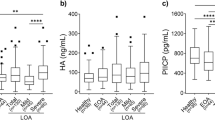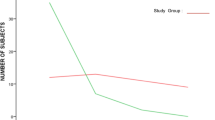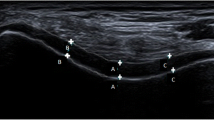Abstract
Human glycoprotein of cartilage (YKL-40) synthesises chondrocytes and synovial cells in inflammatory conditions or remodels the outer cell matrix in osteoarthritis. The aim of this study was to conduct a parallel analysis between thickness of cartilage and length of osteophytes, ultrasound indicators of joint destruction, with levels of YKL-40 in serum in patients with primary osteoarthritis. Ultrasound findings and concentration of YKL-40(ng/ml) were examined in 88 patients. The average value cartilage thickness measured on medial condyles of the femur was 1.30 ± 0.23 mm and on lateral was 1.39 ± 0.27 mm. Median YKL-40 in patients with shorter osteophytes was 62.0 (44.5–90) ng/ml, and with longer osteophytes was 119 (range 80–171) ng/ml (p = 0.000). YKL-40 can be a marker for the appearance of longer osteophytes (sensitivity = 79.1%; specificity = 61.9%;cut off = 75.0 ng/ml). The duration of illness is very much connected to values of YKL-40 (r = 0.651, p = 0.000). After an illness duration of five years, the concentration of YKL-40 was 83.68 ± 33.65 ng/ml, after ten years it was 138.22 ± 48.88 ng/ml, and after 15 and 20 years it was 209.30 ± 79.36 ng/ml and 218.50 ± 106.51 ng/ml, respectively. Higher concentrations of YKL-40 indicate the level of cartilage destruction and can be used for assessment of destruction.
Résumé
La glycoprotéine YKL-40 est synthétisée par les chondrocytes des cellules synoviales lorsqu’il existe une d’inflammation et un remodelage dans l’arthrose du genou. Le but de cette étude est de faire, en parallèle, une analyse entre l’épaisseur du cartilage et la dimension des ostéophytes, les lésions constatées par échographie ainsi que le taux sérique de YKL-40 dans l’arthrose primaire du genou. L’échographie et la concentration de YKL-40 (ng/ml) ont été examinées chez 88 patients. L’épaisseur moyenne du cartilage a été mesurée au niveau du condyle interne du fémur. Elle était de 1,30 +/– 0,233 mm, au niveau du condyle externe elle était de 1,39 +/– 0,27 mm. Le taux moyen de YKL-40 des patients porteurs d’ostéophytes relativement brefs était de 62,0 (44,5–90)ng/ml, pour des ostéophytes plus longs de 119 (80–171)ng/ml (p = 0,000). Le taux sérique de YKL-40 peut donc être un marqueur de la dimension des ostéophytes avec une sensitivité de 79,1% , une spécificité de 61,9%, et un taux limite de 75,0 ng/ml. La durée de l’évolution de la pathologie est également en relation directe avec les valeurs de YKL-40 (r = 0,651 p = 0,000). Après une durée d’évaluation des lésions de moins de 5 ans la concentration d’YKL-40 est de 83,68 +/– 33,65 ng/ml, après 10 ans de 138,22 +/– 48,88 ng/ml et après 15 et 20 ans de 209,30 +/– 79,36 ng/ml et 218,50 +/– 106,51 ng/ml. Une concentration élevée de YKL-40 est donc un indicateur permettant d’évaluer le niveau de destruction du cartilage.



Similar content being viewed by others
References
Pecina-Slaus N, Vukicevic S (2007) Biological mechanisms of bone and cartilage remodeling—genomic perspective. Int Orthop 31:799–805
Bruyère O, Collette JH, Ethgen O, Rovati LC, Giacovelli G, Henrotin YE et al (2003) Biochemical markers of bone and cartilage remodelling for the prediction of long-term progression of knee osteoarthritis. J Rheumatol 30:1043–1050
Conrozier T, Carlier MC, Mathieu P, Colson F, Debard AL, Richard S et al (2000) Serum levels of YKL-40 and C reactive protein in patients with hip osteoarthritis and healthy subjects: a cross sectional study. Ann Rheum Dis 59:828–831
D’Agostino MA, Conaghan P, Le Bars M, Baron G, Grassi W, Martin-Mola E et al (2005) EULAR report on the use of ultrasonography in painful knee osteoarthritis. Part 1: prevalence of inflammation in osteoarthritis. Ann Rheum Dis 64(12):1703–1709
Garnero P, Pipernoc M, Gineytsa E, Christgaud S, Delmasa PD, Vignonc E (2001) Cross sectional evaluation of biochemical markers of bone, cartilage, and synovial tissue metabolism in patients with knee osteoarthritis: relations with disease activity and joint damage. Ann Rheum Dis 60:619–626
Hakala BE et al (1993) Human cartilage gp-39, a major secretory product of articular chondrocytes and synovial cells, is a mammalian member of a chitinase protein family. J Biol Chem 268:25803–25810
Harvey S, Michael W, James O’D, Tonya S, Mindy K, Cathy S (1998) Chondrex: new marker of joint disease. Clin Chem 44:509–516
Johansen JS, Hvolris J, Hansen M, Backer V, Lorenzen I, Price PA (1996) Serum YKL-40 levels in healthy children and adults. Comparison with serum and synovial fluid levels of YKL-40 in patients with osteoarthritis or trauma of the knee joint. Br J Rheumatol 35(6):553–559
Johansen JS, Jensen HS, Price PA (1993) A new biochemical marker for joint injury. Analysis of YKL-40 in serum and synovial fluid. Br J Rheumatol 32(11):949–955
Johansen JS, Olee T, Price PA, Hashimoto S, Ochs RL, Lotz M (2001) Regulation of YKL-40 production by human articular chondrocytes. Arthritis Rheum 44(4):826–837
Kane D, Balint PV, Sturrock RD (2003) Ultrasonography is superior to clinical examination in the detection and localization of knee joint effusion in rheumatoid arthritis. J Rheumatol 30(5):966–971
Kawasaki M, Hasegawa Y, Kondo S, Iwata H (2001) Concentration and localization of YKL-40 in hip joint diseases. J Rheumatol 28(2):341–345
Kraus VB (2005) Biomarkers in osteoarthritis. Curr Opin Rheumatol 17:641–646
Martel-Pelletier J (1999) Pathophysiology of osteoarthritis. Osteoarthr Cartil 7:371–373
Mc Gonagle D, Gibbon W, O’Connor P, Blythe D, Wakefield R, Green M et al (1999) Preliminary study of ultrasound aspiration of bone erosion in early rheumatoid arthritis. Rheumatology 38(4):329–331
Morgante M, Metelli MR, Morgante D (2001) Observations on the increased serum levels of YKL-40 in patients with rheumatoid arthritis and osteoarthritis. Minerva Med 92(3):151–153
Naredo E, Cabero F, Palop MJ, Collado P, Cruz A, Crespo M (2005) Ultrasonographic findings in knee osteoarthritis: a comparative study with clinical and radiographic assessment. Osteoarthr Cartil 13(7):568–574
Register T, Carlson C, Adams M (2001) Serum YKL-40 is associated with osteoarthritis and atherosclerosis in nonhuman primates. Clin Chem 47:2159–2161
Vignon E, Garnero P, Avouac B, Bettica P, Boers M, Delmas P et al (2001) Recommendations for the registration of drugs used in the treatment of osteoarthritis: an update on biochemical markers. Osteoarthr Cartil 9:289–293
Volck B, Johansen JS, Stoltenberg M, Garbarsch C, Price PA, Ostergaard M et al (2001) Studies on YKL-40 in knee joints of patients with rheumatoid arthritis and osteoarthritis. Involvement of YKL-40 in the joint pathology. Osteoarthr Cartil 9(3):203–214
Volck B, Ostergaard K, Johansen JS, Garbarsch C, Price PA (1999) The distribution of YKL-40 in osteoarthritic and normal human articular cartilage. Scand J Rheumatol 1999 28(3):171–179
Author information
Authors and Affiliations
Corresponding author
Rights and permissions
About this article
Cite this article
Živanović, S., Rackov, L.P., Vojvodić, D. et al. Human cartilage glycoprotein 39—biomarker of joint damage in knee osteoarthritis. International Orthopaedics (SICOT) 33, 1165–1170 (2009). https://doi.org/10.1007/s00264-009-0747-8
Received:
Revised:
Accepted:
Published:
Issue Date:
DOI: https://doi.org/10.1007/s00264-009-0747-8




